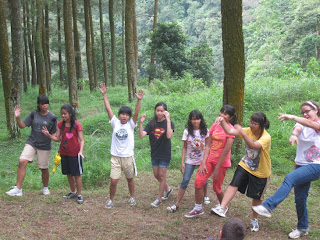After living in the village for a few days our group headed to Salatiga! Before arriving, we visited a group of university students, learned about their lives, the university, and the city, and shared about our lives as Americans and from our recent experiences in the village. Before leaving we got to see the prayer caves (pictured left) mainly used by Christians and big enough for a few people. After arriving in Salatiga, we went to a university where we were able to visit their music department and hear performances from some of the students (pictured right). Many were quite talented and a joy to listen to! Here the majority are playing guitars and one is on the drum.


In Salatiga one of our activities was to head to the streets and learn about the diversity of the area. While the city is located in central Java and the majority of people are Javanese and speak the local language, Javanese, along with Indonesian, people from all over Indonesia have come to the Salatiga area, especially attracted by the universities to make it a diverse city. The group I accompanied headed to the city market to have some fun, look around, interview people, and learn! Here's some shots from our time...
 |
| This is the main street in Salatiga. The large, pink building with towers on the right is the main city market. Photos from within can be seen below. (Right) Our group hits the streets in Salatiga! |
 |
The becak is one of the older forms of public transportation in Indonesia.
They seem to quickly becoming obsolete in many places around Indonesia as motorcycles are now owned by more and more, but the streets near the market area of Salatiga were lined with these colorful becaks. The drivers, when not napping, will steer and pedal from the back with the passengers sitting in the front. |
 |
Inside the market (Left)
The motorcycles on the left are parked while the
owners do their shopping and on the right are a row
of shops with all kinds of goods - clothes, tools,
videos, souvenirs, and lots more. Outside, the
market continued (photo above) with lots of fresh
foods - vegetables, fruits, and meats! |

 |
And finally a couple photos from our interviews. Although
the language barrier was a problem for some, we were able
to communicate to a certain extent and learned quite a bit!
(Left) Austin was a big attraction and we took advantage
by snapping a couple shots with these gentlemen who appear to be
shoes salesmen or shoe repairers.
(Above) Catherine visited with a lady who sold DVDs and of course her toddler was lots of fun. In the background, Melody is visiting with the owner of the store behind them. |


















































